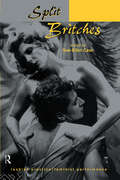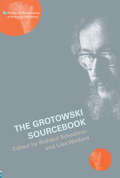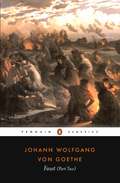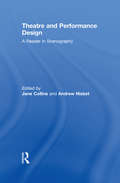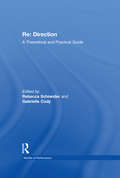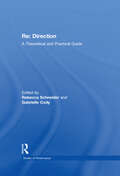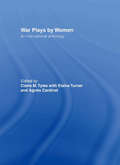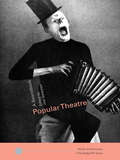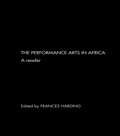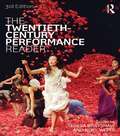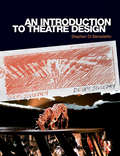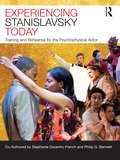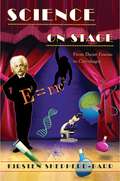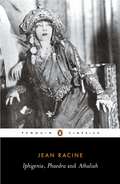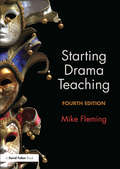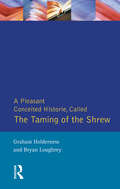- Table View
- List View
Split Britches: Lesbian Practice/Feminist Performance
by Sue-Ellen CaseThe Split Britches theatre company have led the way in innovative and challenging lesbian performance for the last decade. Split Britches: Lesbian Practice/Feminist Performance is a long awaited celebration of the theatre and writing of Lois Weaver, Peggy Shaw and Deborah Margolin, who make up this outstanding troupe. This unique anthology comes complete with: * seven of Split Britches' best loved performance texts * a critical, historical introduction by Sue-Ellen Case * programme notes to accompany each of the plays * a range of stunning photographic illustrations The publication of the Split Britches play texts, collected here for the first time, provides invaluable access to these celebrated performance pieces for both the student and contemporary arts audience.
Split Britches: Lesbian Practice/Feminist Performance
by Sue-Ellen CaseThe Split Britches theatre company have led the way in innovative and challenging lesbian performance for the last decade. Split Britches: Lesbian Practice/Feminist Performance is a long awaited celebration of the theatre and writing of Lois Weaver, Peggy Shaw and Deborah Margolin, who make up this outstanding troupe. This unique anthology comes complete with: * seven of Split Britches' best loved performance texts * a critical, historical introduction by Sue-Ellen Case * programme notes to accompany each of the plays * a range of stunning photographic illustrations The publication of the Split Britches play texts, collected here for the first time, provides invaluable access to these celebrated performance pieces for both the student and contemporary arts audience.
The Grotowski Sourcebook (Worlds of Performance)
by Richard Schechner Lisa Wolford WylamThis acclaimed volume is the first to provide a comprehensive overview of Jerzy Grotowski's long and multi-faceted career. It is essential reading for anyone interested in Grotowski's life and work.Edited by the two leading experts on Grotowski, the sourcebook features:*essays from the key performance theorists who worked with Grotowski, including Eugenio Barba, Peter Brook, Jan Kott, Eric Bentley, Harold Clurman, and Charles Marowitz*writings which trace every phase of Grotowski's career from his 'theatre of production' to 'objective drama' and 'art as vehicle'*a wide-ranging collection of Grotowski's own writings, plus an interview with his closest collaborator and 'heir', Thomas Richards*an array of photographs documenting Grotowski and his followers in action*a historical-critical study of Grotowski by Richard Schechner.
Faust: Ein Mythos Und Seine Bearbeitungen
by Johann Wolfgang Goethe Philip WayneThe second part of Goethe's masterpiece opens with Faust struggling to recover from the death of his beloved Gretchen. The quick-witted demon Mephistopheles soon persuades him to look beyond his sorrow and enter the world of politics and power, but the great scholar is still eager for new sensations, and asks Mephistopheles to reveal Helen of Troy to him in a vision. Overwhelmed by her beauty, Faust demands she be brought back from the underworld - but even this fails to bring him contentment, and his appetite for knowledge remains unsated. Completed a few months before Goethe's death, this rich and allusive work weaves together a wealth of diverse philosophical ideas and influences, reworking the medieval myth of Dr Faustus and speculating upon the search for truth in the Age of Enlightenment.
The Grotowski Sourcebook (Worlds of Performance)
by Richard Schechner Lisa Wolford WylamThis acclaimed volume is the first to provide a comprehensive overview of Jerzy Grotowski's long and multi-faceted career. It is essential reading for anyone interested in Grotowski's life and work.Edited by the two leading experts on Grotowski, the sourcebook features:*essays from the key performance theorists who worked with Grotowski, including Eugenio Barba, Peter Brook, Jan Kott, Eric Bentley, Harold Clurman, and Charles Marowitz*writings which trace every phase of Grotowski's career from his 'theatre of production' to 'objective drama' and 'art as vehicle'*a wide-ranging collection of Grotowski's own writings, plus an interview with his closest collaborator and 'heir', Thomas Richards*an array of photographs documenting Grotowski and his followers in action*a historical-critical study of Grotowski by Richard Schechner.
Theatre and Performance Design: A Reader in Scenography
by Jane Collins Andrew NisbetTheatre and Performance Design: A Reader in Scenography is an essential resource for those interested in the visual composition of performance and related scenographic practices. Theatre and performance studies, cultural theory, fine art, philosophy and the social sciences are brought together in one volume to examine the principle forces that inform understanding of theatre and performance design. The volume is organised thematically in five sections: looking, the experience of seeing space and place the designer: the scenographic bodies in space making meaning This major collection of key writings provides a much needed critical and contextual framework for the analysis of theatre and performance design. By locating this study within the broader field of scenography – the term increasingly used to describe a more integrated reading of performance – this unique anthology recognises the role played by all the elements of production in the creation of meaning. Contributors include Josef Svoboda, Richard Foreman, Roland Barthes, Oscar Schlemmer, Maurice Merleau-Ponty, Richard Schechner, Jonathan Crary, Elizabeth Wilson, Henri Lefebvre, Adolph Appia and Herbert Blau.
Theatre and Performance Design: A Reader in Scenography
by Jane Collins Andrew NisbetTheatre and Performance Design: A Reader in Scenography is an essential resource for those interested in the visual composition of performance and related scenographic practices. Theatre and performance studies, cultural theory, fine art, philosophy and the social sciences are brought together in one volume to examine the principle forces that inform understanding of theatre and performance design. The volume is organised thematically in five sections: looking, the experience of seeing space and place the designer: the scenographic bodies in space making meaning This major collection of key writings provides a much needed critical and contextual framework for the analysis of theatre and performance design. By locating this study within the broader field of scenography – the term increasingly used to describe a more integrated reading of performance – this unique anthology recognises the role played by all the elements of production in the creation of meaning. Contributors include Josef Svoboda, Richard Foreman, Roland Barthes, Oscar Schlemmer, Maurice Merleau-Ponty, Richard Schechner, Jonathan Crary, Elizabeth Wilson, Henri Lefebvre, Adolph Appia and Herbert Blau.
Re: A Theoretical and Practical Guide (Worlds of Performance)
by Gabrielle Cody Rebecca SchneiderRe: Direction is an extraordinary resource for practitioners and students on directing. It provides a collection of ground-breaking interviews, primary sources and essays on 20th century directing theories and practices around the world. Helpfully organized into four key areas of the subject, the book explores: * theories of directing * the boundaries of the director's role * the limits of categorization * the history of the theatre and performance art. Exceptionally useful and thought-provoking introductory essays by editors Schneider and Cody guide you through the wealth of materials included here. Re: Direction is the kind of book anyone interested in theatre history should own, and which will prove an indispensable toolkit for a lifetime of study.
Re: A Theoretical and Practical Guide (Worlds of Performance)
by Gabrielle Cody Rebecca SchneiderRe: Direction is an extraordinary resource for practitioners and students on directing. It provides a collection of ground-breaking interviews, primary sources and essays on 20th century directing theories and practices around the world. Helpfully organized into four key areas of the subject, the book explores: * theories of directing * the boundaries of the director's role * the limits of categorization * the history of the theatre and performance art. Exceptionally useful and thought-provoking introductory essays by editors Schneider and Cody guide you through the wealth of materials included here. Re: Direction is the kind of book anyone interested in theatre history should own, and which will prove an indispensable toolkit for a lifetime of study.
War Plays by Women: An International Anthology
by Agnes Cardinal Elaine Turner Claire M. TyleeThis anthology consists of ten plays from countries involved in the First World War, including plays from Germany and France never before available in translation. Representing a range of dramatic forms, from radio play to street-epic, from comic sketch to musical, this anthology includes plays from: Gertrude Stein, Muriel Box, Marion Wentworth Craig, Dorothy Hewett, Berta Lask, Marie Leneru, Wendy Lill, Alice Dunbar Nelson, and Christina Reid. Highly successful in their day, these plays demonstrate how women have attempted to use theatre to achieve social change. The collection explores the historical development of theatrical conventions and genres and the historical context of social and gender issues.
War Plays by Women: An International Anthology
by Agnes Cardinal Elaine Turner Claire M. TyleeThis anthology consists of ten plays from countries involved in the First World War, including plays from Germany and France never before available in translation. Representing a range of dramatic forms, from radio play to street-epic, from comic sketch to musical, this anthology includes plays from: Gertrude Stein, Muriel Box, Marion Wentworth Craig, Dorothy Hewett, Berta Lask, Marie Leneru, Wendy Lill, Alice Dunbar Nelson, and Christina Reid. Highly successful in their day, these plays demonstrate how women have attempted to use theatre to achieve social change. The collection explores the historical development of theatrical conventions and genres and the historical context of social and gender issues.
Popular Theatre: A Sourcebook (Worlds of Performance)
by Joel SchechterBertolt Brecht turned to cabaret; Ariane Mnouchkine went to the circus; Joan Littlewood wanted to open a palace of fun. These were a few of the directors who turned to popular theatre forms in the last century, and this sourcebook accounts for their attraction.Popular theatre forms introduced in this sourcebook include cabaret, circus, puppetry, vaudeville, Indian jatra, political satire, and physical comedy. These entertainments are highly visual, itinerant, and readily understood by audiences. Popular Theatre: A Sourcebook follows them around the world, from the bunraku puppetry of Japan to the masked topeng theatre of Bali to South African political satire, the San Francisco Mime Troupe's comic melodramas, and a 'Fun Palace' proposed for London.The book features essays from the archives of The Drama Review and other research. Contributions by Roland Barthes, Hovey Burgess, Marvin Carlson, John Emigh, Dario Fo, Ron Jenkins, Joan Littlewood, Brooks McNamara, Richard Schechner, and others, offer some of the most important, informative, and lively writing available on popular theatre. Introducing both Western and non-Western popular theatre practices, the sourcebook provides access to theatrical forms which have delighted audiences and attracted stage artists around the world.
Popular Theatre: A Sourcebook (Worlds of Performance)
by Joel SchechterBertolt Brecht turned to cabaret; Ariane Mnouchkine went to the circus; Joan Littlewood wanted to open a palace of fun. These were a few of the directors who turned to popular theatre forms in the last century, and this sourcebook accounts for their attraction.Popular theatre forms introduced in this sourcebook include cabaret, circus, puppetry, vaudeville, Indian jatra, political satire, and physical comedy. These entertainments are highly visual, itinerant, and readily understood by audiences. Popular Theatre: A Sourcebook follows them around the world, from the bunraku puppetry of Japan to the masked topeng theatre of Bali to South African political satire, the San Francisco Mime Troupe's comic melodramas, and a 'Fun Palace' proposed for London.The book features essays from the archives of The Drama Review and other research. Contributions by Roland Barthes, Hovey Burgess, Marvin Carlson, John Emigh, Dario Fo, Ron Jenkins, Joan Littlewood, Brooks McNamara, Richard Schechner, and others, offer some of the most important, informative, and lively writing available on popular theatre. Introducing both Western and non-Western popular theatre practices, the sourcebook provides access to theatrical forms which have delighted audiences and attracted stage artists around the world.
The Performance Arts in Africa: A Reader
by Frances HardingThe Performance Arts in Africa is the first anthology of key writings on African performance from many parts of the continent. As well as play texts, off the cuff comedy routines and masquerades, this exciting collection encompasses community-based drama, tourist presentations, television soap operas, puppet theatre, dance, song, and ceremonial ritualised performances. Themes discussed are: * theory * performers and performing * voice, language and words * spectators, space and time. The book also includes an introduction which examines some of the crucial debates, past and present, surrounding African performance. The Performance Arts of Africa is an essential introduction for those new to the field and is an invaluable reference source for those already familiar with African performance.
The Performance Arts in Africa: A Reader
by Frances HardingThe Performance Arts in Africa is the first anthology of key writings on African performance from many parts of the continent. As well as play texts, off the cuff comedy routines and masquerades, this exciting collection encompasses community-based drama, tourist presentations, television soap operas, puppet theatre, dance, song, and ceremonial ritualised performances. Themes discussed are: * theory * performers and performing * voice, language and words * spectators, space and time. The book also includes an introduction which examines some of the crucial debates, past and present, surrounding African performance. The Performance Arts of Africa is an essential introduction for those new to the field and is an invaluable reference source for those already familiar with African performance.
The Twentieth Century Performance Reader
by Teresa Brayshaw Noel WittsThe Twentieth-Century Performance Reader has been the key introductory text to all types of performance for over fifteen years. Extracts from over fifty practitioners, critics and theorists from the fields of dance, drama, music, theatre and live art form an essential sourcebook for students, researchers and practitioners. This carefully revised third edition offers focus on contributions from the world of music, and also privileges the voices of practitioners themselves ahead of more theoretical writing. A bestseller since its original publication in 1996, this new edition has been expanded to include contributions from: Bobby Baker; Joseph Beuys; Rustom Bharucha; Anne Teresa de Keersmaeker; Hanns Eisler; Karen Finley; Philip Glass; Guillermo Gómez-Peña; Matthew Goulish; Martha Graham; Wassily Kandinsky; Jacques Lecoq; Hans-Thies Lehmann; George Maciunas; Ariane Mnouchkine; Meredith Monk; Lloyd Newson; Carolee Schneemann; Gertrude Stein; Bill Viola. Each extract is fully supplemented by a contextual summary, a biography of the writer, and suggestions for further reading. The volume’s alphabetical structure invites the reader to compare and cross-reference major writings on all types of performance outside of the constraints and simplifications of genre, encouraging cross-disciplinary understandings. All who engage with live, innovative performance, and the interplay of radical ideas, will find this collection invaluable.
The Twentieth Century Performance Reader
by Teresa Brayshaw Noel WittsThe Twentieth-Century Performance Reader has been the key introductory text to all types of performance for over fifteen years. Extracts from over fifty practitioners, critics and theorists from the fields of dance, drama, music, theatre and live art form an essential sourcebook for students, researchers and practitioners. This carefully revised third edition offers focus on contributions from the world of music, and also privileges the voices of practitioners themselves ahead of more theoretical writing. A bestseller since its original publication in 1996, this new edition has been expanded to include contributions from: Bobby Baker; Joseph Beuys; Rustom Bharucha; Anne Teresa de Keersmaeker; Hanns Eisler; Karen Finley; Philip Glass; Guillermo Gómez-Peña; Matthew Goulish; Martha Graham; Wassily Kandinsky; Jacques Lecoq; Hans-Thies Lehmann; George Maciunas; Ariane Mnouchkine; Meredith Monk; Lloyd Newson; Carolee Schneemann; Gertrude Stein; Bill Viola. Each extract is fully supplemented by a contextual summary, a biography of the writer, and suggestions for further reading. The volume’s alphabetical structure invites the reader to compare and cross-reference major writings on all types of performance outside of the constraints and simplifications of genre, encouraging cross-disciplinary understandings. All who engage with live, innovative performance, and the interplay of radical ideas, will find this collection invaluable.
An Introduction to Theatre Design
by Stephen Di BenedettoThis introduction to theatre design explains the theories, strategies, and tools of practical design work for the undergraduate student. Through its numerous illustrated case studies and analysis of key terms, students will build an understanding of the design process and be able to: identify the fundamentals of theatre design and scenography recognize the role of individual design areas such as scenery, costume, lighting and sound develop both conceptual and analytical thinking Communicate their own understanding of complex design work trace the traditions of stage design, from Sebastiano Serlio to Julie Taymor. Demonstrating the dynamics of good design through the work of influential designers, Stephen Di Benedetto also looks in depth at script analysis, stylistic considerations and the importance of collaboration to the designer’s craft. This is an essential guide for students and teachers of theatre design. Readers will form not only a strong ability to explain and understand the process of design, but also the basic skills required to conceive and realise designs of their own.
Experiencing Stanislavsky Today: Training and Rehearsal for the Psychophysical Actor
by Stephanie Daventry French Philip G. BennettThis pioneering introduction to Stanislavsky's methods and modes of actor training covers all of the essential elements of his System. Recreating ‘truthful’ behaviour in the artificial environment, awareness and observation, psychophysical work, given circumstances, visualization and imagination, and active analysis are all introduced and explored. Each section of the book is accompanied by individual and group exercises, forming a full course of study in the foundations of modern acting. A glossary explains the key terms and concepts that are central to Stanislavsky’s thinking at a glance. The book’s companion website is full of downloadable worksheets and resources for teachers and students. Experiencing Stanislavsky Today is enhanced by contemporary findings in psychology, neuroscience, anatomy and physiology that illuminate the human processes important to actors, such as voice and speech, creativity, mind-body connection, the process and the production of emotions on cue. It is the definitive first step for anyone encountering Stanislavsky’s work, from acting students exploring his methods for the first time, to directors looking for effective rehearsal tools and teachers mapping out degree classes.
Experiencing Stanislavsky Today: Training and Rehearsal for the Psychophysical Actor
by Stephanie Daventry French Philip G. BennettThis pioneering introduction to Stanislavsky's methods and modes of actor training covers all of the essential elements of his System. Recreating ‘truthful’ behaviour in the artificial environment, awareness and observation, psychophysical work, given circumstances, visualization and imagination, and active analysis are all introduced and explored. Each section of the book is accompanied by individual and group exercises, forming a full course of study in the foundations of modern acting. A glossary explains the key terms and concepts that are central to Stanislavsky’s thinking at a glance. The book’s companion website is full of downloadable worksheets and resources for teachers and students. Experiencing Stanislavsky Today is enhanced by contemporary findings in psychology, neuroscience, anatomy and physiology that illuminate the human processes important to actors, such as voice and speech, creativity, mind-body connection, the process and the production of emotions on cue. It is the definitive first step for anyone encountering Stanislavsky’s work, from acting students exploring his methods for the first time, to directors looking for effective rehearsal tools and teachers mapping out degree classes.
Science on Stage: From Doctor Faustus to Copenhagen (PDF)
by Kirsten Shepherd-BarrScience on Stage is the first full-length study of the phenomenon of "science plays"--theatrical events that weave scientific content into the plot lines of the drama. The book investigates the tradition of science on the stage from the Renaissance to the present, focusing in particular on the current wave of science playwriting. Drawing on extensive interviews with playwrights and directors, Kirsten Shepherd-Barr discusses such works as Michael Frayn's Copenhagen and Tom Stoppard's Arcadia. She asks questions such as, What accounts for the surge of interest in putting science on the stage? What areas of science seem most popular with playwrights, and why? How has the tradition evolved throughout the centuries? What currents are defining it now? And what are some of the debates and controversies surrounding the use of science on stage? Organized by scientific themes, the book examines selected contemporary plays that represent a merging of theatrical form and scientific content--plays in which the science is literally enacted through the structure and performance of the play. Beginning with a discussion of Christopher Marlowe's Doctor Faustus, the book traces the history of how scientific ideas (quantum mechanics and fractals, for example) are dealt with in theatrical presentations. It discusses the relationship of science to society, the role of science in our lives, the complicated ethical considerations of science, and the accuracy of the portrayal of science in the dramatic context. The final chapter looks at some of the most recent and exciting developments in science playwriting that are taking the genre in innovative directions and challenging the audience's expectations of a science play. The book includes a comprehensive annotated list of four centuries of science plays, which will be useful for teachers, students, and general readers alike.
Iphigenia, Phaedra, Athaliah
by Jean Racine John CairncrossStrongly influenced by Classical drama, Jean Racine (1639-99) broke away from the grandiose theatricality of baroque drama to create works of intense psychological realism, with characters manipulated by cruel and vengeful gods. Iphigenia depicts a princess's absolute submission to her father's will, despite his determination to sacrifice her to gain divine favour before going to war. Described by Voltaire as 'the masterpiece of the human mind', Phaedra shows a woman's struggle to overcome her overwhelming passion for her stepson - an obsession that brings destruction to a noble family. And Athaliah portrays a ruthless pagan queen, who defies Jehovah in her desperate attempt to keep the throne of Jerusalem from its legitimate heir.
Character Costume Figure Drawing: Step-by-Step Drawing Methods for Theatre Costume Designers
by Tan HuaixiangCharacter Costume Figure Drawing is an essential guide that will improve your drawing skills and costume renderings. Step-by-step visuals illustrate the how-tos of drawing body parts, costumes, accessories, faces, children, and different character archetypes, such as maternal, elderly, sassy, sexy, and evil. By focusing on the foundations of drawing bodies, including body proportion, bone structure, body masses, facial expressions, and appendages, this guide shows you how to develop sketches from stick figures to full-blown characters. The third edition features a new chapter, Digital Mixed Media Costume Rendering. This chapter introduces the basic usages of Photoshop tools to enhance and improve costume designs, in order to provide easy delivery design ideas to the director and design team, provide easy changes and alterations during the design process, virtually apply actual fabric swatches over costume sketches, and help visualize lighting effects.
Starting Drama Teaching
by Mike FlemingWhy teach drama? How can a newcomer teach drama successfully? How do we recognize quality in drama? Starting Drama Teaching is a comprehensive guide to the teaching of drama in schools. Exploring the aims and purposes of drama, it provides an insight into the theoretical perspectives that underpin practice alongside activities, example lesson plans and approaches to planning. Written in an accessible style, the book addresses such practical issues as setting up role play, how to inject depth into group drama, working with text, teaching playwriting, as well as common problems that arise in the drama classroom and how to avoid them. This fourth edition has been updated to reflect the latest educational thinking and developments in policy and includes: a new chapter on researching drama; an extra section on digital technology and drama; guidance on different approaches to drama; advice on how teachers can achieve and recognize quality work in drama; a discussion of drama concepts including applied theatre, ensemble and rehearsal approaches. Acting on the growing interest in drama both as a separate subject and as a teaching methodology, this book is full of sensible, practical advice for teachers using drama at all levels and in all kinds of different school contexts. Written by an internationally recognized leading name in drama education, this book is valuable reading for trainee teachers who are new to drama and teachers who wish to update and broaden their range.
Taming of the Shrew: First Quarto of "Taming of a Shrew"
by Graham Holderness Bryan LoughreyFirst Published in 1992. This series puts into circulation single annotated editions of early modern play-texts whose literary and theatrical histories have been overshadowed by editorial practices dominant since the eighteenth century. The text contained in this volume is not what we know as Shakespeare's The Taming of the Shrew, modern editions of which play are all derived from the text printed in the 1623 First Folio edition of Shakespeare's works. The present text is an edition of the play published in 1594 under the title The Taming of a Shrew, which has always been denied the authorising signature of 'Shakespeare', and regarded as an earlier version by another dramatist or as a pirated and corrupt 'memorial reconstruction' of Shakespeare's The Taming of the Shrew.
